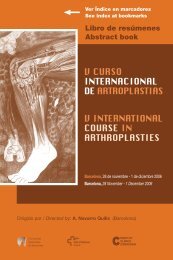Notas / Notes - Active Congress.......
Notas / Notes - Active Congress.......
Notas / Notes - Active Congress.......
You also want an ePaper? Increase the reach of your titles
YUMPU automatically turns print PDFs into web optimized ePapers that Google loves.
JUEVES / THURSDAY<br />
142<br />
to be detrimental. High patellofemoral loads are also thought<br />
to contribute to cartilage deterioration over time.<br />
Recent prospective, randomized studies favor patellar resurfacing<br />
over retaining the native patella, reporting increased<br />
reoperation rates for patellar problems and increased anterior<br />
knee pain in subjects in which the patella has not been resurfaced.<br />
These studies also document the reoperation rates to<br />
convert unresurfaced to resurfaced patellae exceeding those<br />
for complications after patellar resurfacing. In addition, the<br />
incidence of residual patellofemoral pain after secondary resurfacing<br />
is substantially higher than when patellofemoral<br />
resurfacing is done primarily. Therefore, one cannot be assured<br />
of an equivalent result (as compared with primary resu-rfacing)<br />
with secondary patellar resurfacing if substantial patellofemoral<br />
pain occurs following TKA without initial patellar resurfacing.<br />
Most studies of subjects in which bilateral TKA has been performed<br />
with the patella resurfaced in one TKA and nonresurfaced<br />
in the other have demonstrated patients prefer the TKA<br />
with the resurfaced patella. Lastly, studies which have analyzed<br />
intraoperative cartilage condition at the time of TKA have found<br />
a poor correlation between intraoperative cartilage condition<br />
and postoperative patellar pain and function, supporting the<br />
concept that it is difficult to determine who will do well clinically<br />
without patellar resurfacing based on intraoperative findings.<br />
Patient selection criteria are critical in the decision-making<br />
process. Patellofemoral complications, the greatest argument<br />
against resurfacing, have been diminished with improved surgical<br />
techniques and implant design. Surgical techniques for<br />
patellar resurfacing that emphasize a patellar resection that<br />
reproduces equal facet thickness, native patellar height and<br />
central patellar tracking, while respecting vascular principles,<br />
have produced complication rates which range from 0% to<br />
4%. This is superior to a 10-29% patellofemoral pain incidence<br />
demonstrated in review of the literature of series without patellar<br />
resurfacing. If resurfacing is chosen, adherence to proper<br />
surgical technique principles is imperative as outlined below.<br />
I. SURGICAL TECHNIQUE GOALS<br />
A. Preserve the Patellar Tendon<br />
B. Duplicate Patellar Thickness<br />
C. Assure Patellar Symmetry<br />
D. Assure Patellar Tracking<br />
E. Preserve Patellar Vascularity<br />
II. PRESERVE THE PATELLAR TENDON<br />
A. Release Infrapatellar Adhesions<br />
B. Release Patellofemoral Ligament<br />
C. Extend Capsulotomy<br />
D. Externally Rotate Tibia<br />
E. Secure (Clamp) Tendon Insertion<br />
III. DUPLICATE PATELLAR THICKNESS<br />
A. Measure Patellar Thickness<br />
1. Highly Variable (Average 20-25 mm)<br />
B. Measure Patellar Component Thickness<br />
1. Usually 8.5-11 mm<br />
C. Remove What You’re Replacing<br />
IV. ASSURE PATELLAR SYMMETRY<br />
A. Normal Anatomy<br />
1. Medial Thicker Than Lateral Facet<br />
B. Minimal Lateral Facet Resection<br />
1. Typically Flush With Subchondral Bone<br />
C. Measure Symmetry Post-Resection<br />
D. Don’t Over-resect To Obtain Flat Surface<br />
1. Asymmetric Patella ≥ Instability<br />
2. Lateral Defect ≥ Drill & Fill (PMMA)<br />
V. ASSURE PATELLAR TRACKING<br />
A. Surgical Approach<br />
1. Superior Tracking with Mid-Vastus/Subvastus<br />
B. Proper Component Positioning<br />
1. Femoral - Avoid Medial Shift / Internal<br />
Rotation / Excessive<br />
Valgus / Femoral Component Flexion<br />
a. Transepicondylar Axis: Place Parallel To<br />
b. Anteroposterior Axis: Place Perpendicular To<br />
2. Tibial - Avoid Medial Shift / Internal Rotation<br />
3. Patella - Avoid Lateral Shift<br />
a. Median Crest (High Point) Is 5.42 mm<br />
(Average) Medial To Midpoint Of Patella<br />
(Hofmann, et al, J. Arthroplasty, 1997)<br />
b. Predrill Median Crest - Marker Of Median Crest<br />
c. Position Highpoint of Dome Over Median Crest<br />
C. Lateral Retinacular Release / VMO Imbrication If<br />
Subluxation<br />
D. Assessment<br />
1. No Thumb Technique<br />
2. Assess After Tourniquet Release<br />
a. Tourniquet Creates Tenodesis Effect<br />
VI. PRESERVE PATELLAR VASCULARITY<br />
A. Maintain the Fat Pad<br />
B. Preserve the Superolateral Geniculate Artery<br />
1. If Lateral Release Required<br />
C. Avoid Large Central Lug Component<br />
1. Disrupts Midpatellar Intraosseus Blood Supply<br />
VII. PATELLOFEMORAL PROSTHETIC DESIGN<br />
A. Patellar Component<br />
1. Dome / Modified Dome Shape – More Forgiving<br />
2. Three Small Peripheral Fixation Lugs<br />
a. Less Stress Raiser / Reduced Fracture Risk<br />
B. Femoral Component<br />
1. Anatomic Trochlear Groove<br />
a. Assists Patellar Capture / Reduced Shear<br />
Stresses (Colwell)<br />
2. Extended Trochlear Groove<br />
a. Maximizes Contact Area in Deep Flexion<br />
REFERENCES<br />
1. Boyd Jr AD, Ewald FC, Thomas WH, Poss R, Sledge CB:<br />
Long-term complications after total knee arthroplasty with<br />
or without resurfacing of the patella. J Bone Joint Surg<br />
75A: 674-681, 1993.





